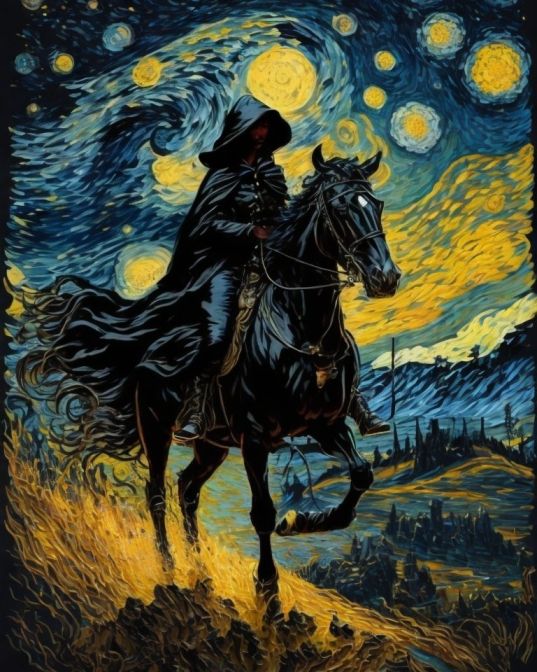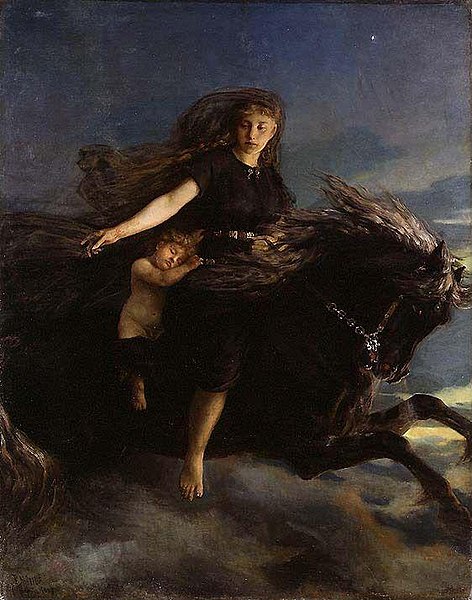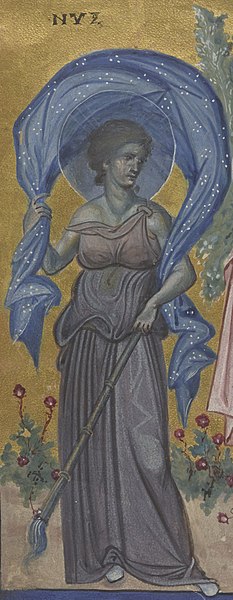In Norse mythology, the lines between the gods and the jotnar is sometimes blurred. This is the case with the jötun Nótt, who is also recognized as the goddess of night. She is one of the celestial beings in Norse myths, the gods and goddesses associated with night and day, sun and the moon.
Nótt actually comes up several places in the old Norse texts. She had different companions, both jotün and gods. These unions again produced both divine children and jotnar. As such, she shares many similarities with the Greek primordial goddess Nyx, also of the night.
Nótt Key Facts
| Attribute | Description |
|---|---|
| Parents | Narfi, mother unknown |
| Partner | Dellingr |
| Siblings | None known |
| Offspring | Dagr (Day), Auðr, and Jörð |
| Tribe | Jötun / Aesir |
| Old Norse Name | Nótt |
| Other Names | Dream-weaver, and others. |
| The God of | Night |
| Ass. Animal | Owl |
Name and Etymology
Nótt, directly translating to “night” in Old Norse, holds a significant place in the Norse pantheon. Her name is not just a simple description of the time after sunset; it carries with it the weight of myths, stories, and cultural significance. In the poem “Alvissmál,” the dwarf Alviss provides various names for night, each reflecting the perspective of different beings in the Norse cosmos:
- Among men: Night
- Among the gods: Mist-Time
- The Holy Powers: Hooded Hour
- The giants: Sorrowless
- The elves: Sleep-joy
- The dwarves: Dream-Weaver
These varied names underscore the multifaceted nature of night in Norse mythology, reflecting its different meanings and significance to various beings.
Ancient roots
The name “Nótt” in Old Norse can be traced back to the Proto-Germanic word nahts. This Proto-Germanic term is the ancestor of several words in modern Germanic languages, including the Old English “niht” (which evolved into the modern English “night”), the German “nacht,” and the Dutch “nacht.”
This linguistic connection suggests a shared understanding and personification of the night across various Germanic cultures. The reverence and significance attributed to the night, and its embodiment as a deity or entity, likely have deep-seated roots in the collective psyche of the Germanic peoples.
Nótt’s Origins
Nótt’s lineage, as depicted in ancient Norse texts, is both intricate and fascinating. In the “Poetic Edda” and the “Prose Edda”—both important works from the 13th century that draw from earlier traditional sources—Nótt is introduced as the daughter of the jötun Nörvi, also known as Narfi. This connection to the jötnar, the giants of Norse mythology, adds a layer of depth to her character, intertwining her with the primal forces of the cosmos. The jotnar are of course closely tied to the very creation of the cosmos.

Nótt’s life is marked by three significant unions, each producing offspring that play pivotal roles in Norse myths. Her first marriage to Naglfari bore a son, Auðr. Following this, Nótt wed Annar, and together they welcomed Jörð, the personified earth, a testament to Nótt’s profound connection to the natural world.
In her final and perhaps most renowned union, Nótt marries the god Dellingr. From this union springs forth Dagr, embodying the day. Dagr’s radiant appearance, described as inheriting the “brightness and fairness” of Dellingr’s lineage, place him among the Aesir. Contrasting beautifully with Nótt’s nocturnal essence, symbolizing the eternal dance between day and night, between the gods and the jotnar.
Roles And Depiction
In the Norse pantheon, Nótt plays a pivotal role. Her arrival heralds the time for rest, reflection, and dreams. For the gods, her presence is a reminder of the cyclical nature of existence; for humans, she offers a respite from the toils of the day. Each evening, she rides her chariot across the sky, paving the way for her son, Dagr, to follow.
Interestingly, night and day are separate from Sol, the sun goddess and her brother Máni, the god of the moon. You find this is much the same in Greek mythology. They to have separate deities personifying the day and night, and sun and moon. Respectively they are, Hemera, Titan goddess of day, Nyx, Titan goddess of night, Helios the Titan sun god, and Selene Titan goddess of the moon.
Myths about Nótt
Nótt, the embodiment of night in Norse mythology, is more than just a passive figure representing darkness. She plays an active role in various myths, proving her significance in the story of the Norse cosmos. While there aren’t a great number of tales centered around her, the ones that do exist highlight her importance and the roles she plays in the larger tapestry of Norse tales.
Nótt and Dagr’s Journey Across the Sky
One of the most prominent myths involving Nótt revolves around her and her son, Dagr (Day). Odin, the Allfather and chief of the Aesir tribe, recognizing the importance of the cyclical nature of day and night, decided to give both Nótt and Dagr a pivotal role in the daily lives of all beings. He placed them in the sky, each with their own chariot, to ride around the Earth every 24 hours.

Nótt rides ahead of Dagr, her chariot drawn by the horse Hrímfaxi. As she journeys across the sky, the foam from Hrímfaxi’s bit falls to the Earth, manifesting as the morning dew. Following her, Dagr, in his radiant chariot, brings light and warmth, dispelling the darkness left in his mother’s wake. This eternal dance between mother and son, night and day, is a testament to the balance and cyclical nature of the universe in Norse belief.
Play Fun Norse Quiz
Is this article making you even more curious about Norse gods and goddesses? You can satisfy your curiosity by playing a fun Norse mythology quiz. This way, you can test your knowledge about Norse gods and goddesses, as well as fill in some gaps. Good luck and have fun playing!
Don’t forget to try our other games as well!
Compare and Contrast with the Greek goddess Nyx
When writing about Nótt, I find it hard not to compare her with the Greek primordial goddess Nyx. They are both personifications of the night, and share similarities in their roles and significance. However, while Nótt is often seen in conjunction with her son Dagr, representing the balance of night and day, Nyx stands more independently in Greek mythology, often associated with mysteries and the unknown.

Yet, their differences are as stark as night and day. Nyx, in Greek myths, is a primordial deity, born from Chaos, and mother to many other deities like Sleep and Death. Nótt, on the other hand, has a more familial role in Norse tales, emphasizing her relationships and lineage. I want to say that her role seems “simpler” and less deeply developed when compared to Nyx.
Mentions in Ancient Texts
Norse mythology is rich with stories that traverse various realms and introduce us to a host of intriguing characters. One such figure is Nótt, the personification of night. Her story and significance are detailed in two primary sources of Norse lore: the Poetic Edda and the Prose Edda. These texts provide insights into Nótt’s lineage, her roles, and her interactions with other beings in the Norse cosmos.
Poetic Edda
Vafþrúðnismál
In the poem Vafþrúðnismál, Odin, under the guise of “Gagnráðr”, seeks knowledge from the jötunn Vafþrúðnir about the origins of day and night. Vafþrúðnir’s response encapsulates the cyclical nature of day and night:
“Delling hight he who the day’s father is,
but night was of Nörvi born;
the new and waning moons the beneficent powers created,
to count the years for men.”
The same poem also mentions the horse Hrímfaxi, which draws the night across the sky:
“Hrímfaxi draws every night to the beneficent gods”
and lets foam from his bit fall every morning,
from which dew comes to the valleys.”
Alvíssmál
In the poem Alvíssmál, Thor asks how night is perceived across the nine worlds. The dwarf Alvíss provides a diverse range of names, reflecting the varied perspectives of different beings:
“Night is referred as ‘night’ by mankind,
‘darkness’ by the gods,
‘the masker’ by the mighty Powers,
‘unlight’ by the jötunn,
‘joy-of-sleep’ by the elves,
while dwarves call her ‘dream-Njörun’ (dream-goddess).”
Sigrdrífumál
In Sigrdrífumál, after the valkyrie Sigrdrífa awakens from her slumber, she offers a prayer that invokes both day and night:
“Hail to the Day! Hail to the sons of Day!
To Night and her daughter hail!
With placid eyes behold us here,
and here sitting give us victory.
Prose Edda
Gylfaginning
In the Gylfaginning section of the Prose Edda, Nótt’s lineage and her significant unions are detailed. She is described as the daughter of a jötunn named “Norfi or Narfi” and is characterized by her “black and swarthy” appearance. The narrative delves into her three marriages and the offspring they produced. Nótt and her son Dagr journey across the sky, riding their chariots in a continuous cycle.
“Odin took Nótt and her son Dagr, placed them into the sky with a chariot and a horse each, and they ride around the Earth every 24 hours. Nótt rides before Dagr, and foam from her horse Hrímfaxi’s bit sprinkles the Earth.”
Frequently Asked Questions
Nótt is the daughter of Narfi.
There are no known siblings of Nótt in Norse mythology.
Nótt represents the night, bringing rest and reflection to both gods and humans.
Dagr, the god of day, is Nótt’s son with Dellingr.
While Nótt shares similarities with other night deities like the Greek Nyx, her role and relationships in Norse mythology make her unique.
Featured Image Credit: Peter Nicolai Arbo, Public domain, via Wikimedia Commons

Thank you for this wonderful info! Its extremely hard to find any info on the Primordial goddess Nott
Appreciate your feedback Nickolas, thanks!